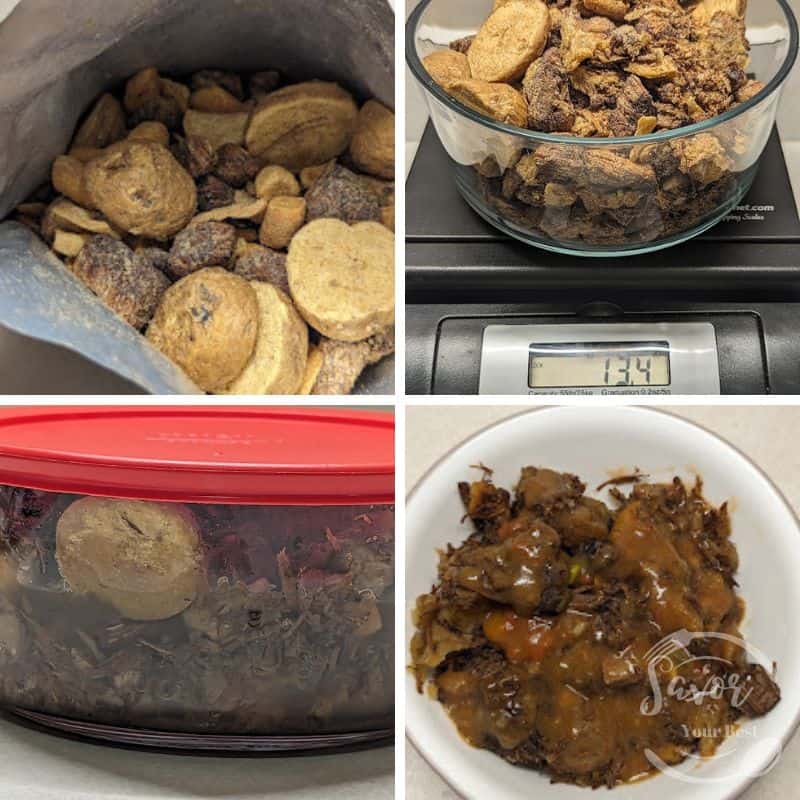How to Calculate Water Loss to Make Freeze Dried Food Rehydration Easy
Freeze drying is like magic for your food! It removes the water from your food while keeping all the good stuff like nutrients and flavors. Food comes out of the freeze dryer airy and crispy and is often a great treat. The true magic is that it can return to its original texture just by adding some water. Freeze dried food rehydration is as simple as that. But you need to add the RIGHT amount of water back into your food, and if you don’t know how to find water loss, this can be tricky.
Why This is SO Important
Adding the right amount of water back helps the food taste and feel like it did before it was freeze dried. If you add too much or too little water, it might taste funny or have a strange texture. But if you measure correctly, it’ll be just like eating fresh food!
So, by knowing how much water your food loses when freeze dried, you can make sure it’s just right when you’re ready to eat it again. It’s like putting the puzzle pieces back together to enjoy your yummy food!
Let’s go through this step-by-step so you can have perfect rehydration every time.

How to Rehydrate Freeze Dried Food
Step 1: Weigh Your Food Before Freeze Drying
First, you need to know how much your food weighs before you freeze dry it. This is called the “wet weight” because the food still has all its water. For example, let’s say you have apple slices that weighs 20 grams before you start freeze drying.
Step 2: Weigh Your Food After Freeze Drying
After freeze drying, weigh the food again. Now, you have what’s called the “dry weight” because all the water is gone. Let’s say your apple slices now weigh 4 grams.
Step 3: Calculate the Water Loss
To find out how much water was lost, subtract the dry weight from the wet weight.
Water Loss = Wet Weight – Dry Weight
So, for our apple slice:
Water Loss = 20 grams – 4 grams = 16 grams
This means 16 grams of water was removed from the apple slices during freeze drying.
Step 4: Use the Water Loss to Rehydrate the Food
To make your freeze dried food taste like fresh, you need to add back the same amount of water that was removed. So, if the apple slice lost 16 grams of water, you’ll need to add 16 grams of water to rehydrate it.
Now, here’s a cool trick: 1 gram of water is the same as 1 milliliter (ml) of water. So you can add 16 ml of water to the freeze dried apple slice.

Step-by-Step Example
Let’s try this with a simple example:
- Weigh Before Freeze Drying: You have a slice of banana that weighs 30 grams.
- Weigh After Freeze Drying: After freeze drying, it weighs 5 grams.
- Calculate Water Loss:
To find out how much water was lost, subtract the dry weight from the wet weight. Water Loss = 30 grams – 5grams Water Loss = 25 grams - Rehydrate: Add 25 ml (or 25 grams) of water to bring the banana back to its original state.
Cold or Hot Liquid?
Now that we have figured out how to calculate the amount of liquid that needs to be added to freeze dried food for perfect rehydration. The temperature of the liquid you use for freeze dried food rehydration can make a big difference in the final texture and taste of your food. Getting the temperature right is KEY to ensuring your meals taste just as fresh as before!
Cold Liquid: Use cold liquid when rehydrating delicate foods like fruits, herbs, or raw vegetables. Cold water helps maintain their crispness and prevents over-softening. For example, freeze dried strawberries rehydrate well in cold water, keeping them firm and fresh-tasting, perfect for adding to cereal or yogurt.
Hot Liquid: Use hot liquid when rehydrating foods that were cooked or blanched before freeze-drying, such as meats, beans, or stews. Hot water speeds up the rehydration process and helps restore the original texture, making it ideal for rehydrating cooked chicken or beef to be used in soups or casseroles.
A good rule of thumb:
If your food went into the freeze dryer raw, you’ll want to rehydrate it with cold water. If it was fully cooked or blanched before freeze drying, use warm or hot water for rehydration.
These are general guidelines, but not always the perfect solution for every situation. Using hot liquid for freeze dried food rehydration usually speeds up the process, but cold liquid can be better depending on your recipe and how you plan to prepare the dish. As you gain more experience working with freeze dried foods, you’ll discover your own preferences and figure out the best methods for rehydrating and cooking with various ingredients.
For more information on how heat affects food during cooking, check out this article.
Avoid Overhydrating Freeze Dried Foods
Rehydrating freeze dried food is quick, but achieving the perfect results can take a bit of time, so patience is key. It might be tempting to add extra liquid to speed things up, but it’s best to resist and allow the food to absorb water gradually for the best texture and flavor.
Freeze dried foods like fruits and vegetables are preserved at their peak, keeping all the vitamins, minerals, and delicious flavors intact. Proper freeze dried food rehydration with the correct amount of liquid helps retain their original texture and taste.
However, adding too much water during freeze dried food rehydration can make fruits and vegetables soggy, causing them to lose their appealing texture and flavor. To avoid overhydration, start each freeze drying batch with the intention of rehydrating later—record both the wet and dry weights so you can calculate the water loss and know exactly how much water to add back for precise rehydration.
If you don’t have those measurements, begin by adding just enough water to cover the bottom of your container, stirring gently for a few minutes until the pieces start to rehydrate. Then, gradually add small amounts of water until you reach your desired texture and taste.
A handy trick is to use a spray bottle to lightly mist freeze dried foods, giving you precise control for perfect rehydration every time.
When to Rehydrate Freeze Dried Food
Many people think that freeze dried food rehydration is always necessary before cooking, but that’s not always the case! Whether you need to rehydrate freeze dried food first depends on how you plan to use it.
- When to Rehydrate: Rehydrate freeze dried ingredients before cooking if you’re not adding water during the cooking process, like when making enchilada sauce. You’ll also want to rehydrate freeze dried ingredients first if they’ll be part of a creamy, thick sauce, such as a casserole filling.
- When to Skip Rehydrating: Skip rehydrating if the freeze dried ingredients are going into watery dishes like soups and stews. In these cases, you can simply add your freeze dried foods directly into the pot with the appropriate amount of water added to your recipe.
Don’t Stop Here…
Unlock the secrets to perfect rehydration with our advanced methods! Go beyond the basic water soak and discover how taking a little extra time can elevate the flavor and texture of your freeze dried foods. Learn how to rehydrate lasagna using techniques that bring back layers of rich, complex flavors and a perfect, just-cooked texture. Plus, we reveal tricks to enhance flavor and presentation, ensuring your rehydrated freeze dried meals are as delicious and visually appealing as fresh ones. Dive in now to transform your freeze dried meals into gourmet experiences!

Also, be sure to also check our post on what type of water is best to rehydrate your freeze dried food. The quality of water you use for rehydrating freeze dried food plays a crucial role in the taste and safety of your meal. The right water helps maintain the food’s original flavor and prevents any unwanted tastes from minerals or contaminants.




